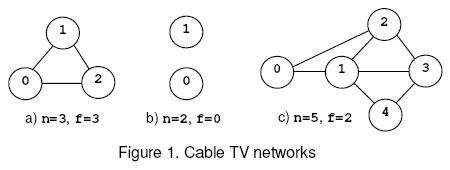Cable TV Network- POJ 1966 连通量
2015-03-25 09:44
337 查看
Cable TV Network
Description
The interconnection of the relays in a cable TV network is bi-directional. The network is connected if there is at least one interconnection path between each pair of relays present in the network. Otherwise the network is disconnected. An empty network or
a network with a single relay is considered connected. The safety factor f of a network with n relays is:
1. n, if the net remains connected regardless the number of relays removed from the net.
2. The minimal number of relays that disconnect the network when removed.

For example, consider the nets from figure 1, where the circles mark the relays and the solid lines correspond to interconnection cables. The network (a) is connected regardless the number of relays that are removed and, according to rule (1), f=n=3. The network
(b) is disconnected when 0 relays are removed, hence f=0 by rule (2). The network (c) is disconnected when the relays 1 and 2 or 1 and 3 are removed. The safety factor is 2.
Input
Write a program that reads several data sets from the standard input and computes the safety factor for the cable networks encoded by the data sets. Each data set starts with two integers: 0<=n<=50,the number of relays in the net, and m, the number of cables
in the net. Follow m data pairs (u,v), u < v, where u and v are relay identifiers (integers in the range 0..n-1). The pair (u,v) designates the cable that interconnects the relays u and v. The pairs may occur in any order.Except the (u,v) pairs, which do not
contain white spaces, white spaces can occur freely in input. Input data terminate with an end of file and are correct.
Output
For each data set, the program prints on the standard output, from the beginning of a line, the safety factor of the encoded net.
Sample Input
Sample Output
题意:在一个无向图中,如果任意两个点之间都有路径,那么这个图就是连通的,空图,或只有一个点也都是连通的。问至少删除多少个点,可以使得这个图变成不连通,如果不能做到,就输出n。
思路:求无向图的连通量,求s到t的最小割,将点拆成i'和i'',i'-i''的流量为1,s和t的都设为INF,图中给定的边,建立双向的流量为1的边。然后求s到t的最大流,就是s到t的最小割。固定源点再枚举汇点,答案最小的那个就是最后的答案。
AC代码如下:
| Time Limit: 1000MS | Memory Limit: 30000K | |
| Total Submissions: 4068 | Accepted: 1903 |
The interconnection of the relays in a cable TV network is bi-directional. The network is connected if there is at least one interconnection path between each pair of relays present in the network. Otherwise the network is disconnected. An empty network or
a network with a single relay is considered connected. The safety factor f of a network with n relays is:
1. n, if the net remains connected regardless the number of relays removed from the net.
2. The minimal number of relays that disconnect the network when removed.

For example, consider the nets from figure 1, where the circles mark the relays and the solid lines correspond to interconnection cables. The network (a) is connected regardless the number of relays that are removed and, according to rule (1), f=n=3. The network
(b) is disconnected when 0 relays are removed, hence f=0 by rule (2). The network (c) is disconnected when the relays 1 and 2 or 1 and 3 are removed. The safety factor is 2.
Input
Write a program that reads several data sets from the standard input and computes the safety factor for the cable networks encoded by the data sets. Each data set starts with two integers: 0<=n<=50,the number of relays in the net, and m, the number of cables
in the net. Follow m data pairs (u,v), u < v, where u and v are relay identifiers (integers in the range 0..n-1). The pair (u,v) designates the cable that interconnects the relays u and v. The pairs may occur in any order.Except the (u,v) pairs, which do not
contain white spaces, white spaces can occur freely in input. Input data terminate with an end of file and are correct.
Output
For each data set, the program prints on the standard output, from the beginning of a line, the safety factor of the encoded net.
Sample Input
0 0 1 0 3 3 (0,1) (0,2) (1,2) 2 0 5 7 (0,1) (0,2) (1,3) (1,2) (1,4) (2,3) (3,4)
Sample Output
0 1 3 0 2
题意:在一个无向图中,如果任意两个点之间都有路径,那么这个图就是连通的,空图,或只有一个点也都是连通的。问至少删除多少个点,可以使得这个图变成不连通,如果不能做到,就输出n。
思路:求无向图的连通量,求s到t的最小割,将点拆成i'和i'',i'-i''的流量为1,s和t的都设为INF,图中给定的边,建立双向的流量为1的边。然后求s到t的最大流,就是s到t的最小割。固定源点再枚举汇点,答案最小的那个就是最后的答案。
AC代码如下:
#include<cstdio>
#include<cstring>
#include<algorithm>
#include<queue>
using namespace std;
struct node
{
int u,v,flow,next;
}edge[100010];
int n,N,m,Head[110],d[110],s,t,tot,INF=1e9,link[60][60],_u[10010],_v[10010];
char str[110];
queue<int> qu;
void add(int u,int v,int f)
{
edge[tot].u=u;
edge[tot].v=v;
edge[tot].flow=f;
edge[tot].next=Head[u];
Head[u]=tot++;
}
void init()
{
memset(Head,-1,sizeof(Head));
tot=0;
int i,j,k,u,v;
for(i=1;i<=m;i++)
{
u=_u[i];
v=_v[i];
add(u*2^1,v*2,1);
add(v*2,u*2^1,0);
add(v*2^1,u*2,1);
add(u*2,v*2^1,0);
}
for(i=1;i<n;i++)
if(i!=t/2)
{
add(i*2,i*2^1,1);
add(i*2^1,i*2,0);
}
add(s*2,s*2^1,INF);
add(s*2^1,s*2,0);
add(t^1,t,INF);
add(t,t^1,0);
}
int bfs()
{
int i,j,u,v;
memset(d,-1,sizeof(d));
while(!qu.empty())
qu.pop();
qu.push(s);
d[s]=0;
while(!qu.empty())
{
u=qu.front();
qu.pop();
for(i=Head[u];i!=-1;i=edge[i].next)
{
v=edge[i].v;
if(edge[i].flow>0 && d[v]==-1)
{
d[v]=d[u]+1;
if(v==t)
return 1;
qu.push(v);
}
}
}
return 0;
}
int dfs(int u,int f)
{
if(u==t || f==0)
return f;
int ans=0,i,j,k,v;
for(i=Head[u];i!=-1;i=edge[i].next)
{
v=edge[i].v;
if(edge[i].flow>0 && d[v]==d[u]+1)
{
k=dfs(v,min(edge[i].flow,f));
edge[i].flow-=k;
edge[i^1].flow+=k;
f-=k;
ans+=k;
if(f==0)
break;
}
}
d[u]=-1;
return ans;
}
int dinic()
{
tot=0;
init();
int ans=0;
while(bfs())
{
ans+=dfs(0,INF);
//printf("---%d\n",ans);
}
return ans;
}
int main()
{
int i,j,k,u,v,minn;
while(~scanf("%d%d",&n,&m))
{
memset(link,0,sizeof(link));
for(i=1;i<=m;i++)
{
scanf("%s",str);
sscanf(str,"(%d,%d)",&u,&v);
link[u][v]=link[v][u]=1;
_u[i]=u;_v[i]=v;
}
minn=INF;
for(i=1;i<n;i++)
if(!link[0][i])
{
s=0;t=i*2^1;
k=dinic();
//printf("%d %d\n",i,k);
minn=min(minn,k);
}
if(minn==INF)
printf("%d\n",n);
else
printf("%d\n",minn);
}
}
相关文章推荐
- POJ 1966 Cable TV Network(顶点连通度)
- poj 1966 Cable TV Network 【枚举源汇 求解 无向图最小割】
- POJ 1966 / ZOJ 2182 : Cable TV Network - 顶点连通度
- poj 1966 Cable TV Network 无向图最小割
- POJ1966--Cable TV Network
- POJ--1966--Cable TV Network【无向图顶点连通度】
- 【连通图|点连通度】POJ-1966 Cable TV Network
- POJ 1966 Cable TV Network 顶点连通度的求解
- POJ 1966 Cable TV Network【SAP】
- POJ 1966 Cable TV Network
- poj 1966 Cable TV Network
- POJ 1966 Cable TV Network (用最大流求最小割点数量)
- poj 1966 Cable TV Network 最大独立轨
- POJ 1966 Cable TV Network(顶点连通度的求解)
- poj 1966 Cable TV Network 顶点连通度-最大流
- POJ 1966 Cable TV Network 无向图的点连通度
- poj 1966 Cable TV Network 顶点连通度-最大流
- POJ 1966--Cable TV Network【最小割 && 枚举终点起点】
- POJ 1966 Cable TV Network 笔记
- poj 1966 zoj 2182 Cable TV Network(无向图顶点连通度(sap求最大流))
